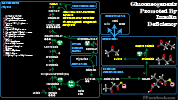Serum Ketone, Serum Acetone, Acetoacetate, Beta-Hydroxybutyrate, Serum Beta Hydroxybutyrate, B-Hydroxybutyrate, 3 Hydroxybutyric Acid, Ketoacidosis, Ketosis, Acetonemia, Ketone Body, Ketone Bodies, Ketone, Ketogenesis
- See Also
- Pathophysiology
- Images
- Ketone Bodies
- Ketones are water-soluble molecules used by cells as fuel (esp. brain, heart) when Glucose is not available
- Most commonly form in Diabetic Ketoacidosis when Insulin is insufficient
- Also forms in Starvation Ketosis or Alcoholic Ketoacidosis when Glucose is insufficient
- Ketone use as a fuel blunts Hypoglycemia effects (esp. neurologic) despite Serum Glucose <60 mg/dl
- Ketones yield 4 kcal/g when metabolized via oxidative pathway
- Liver forms Ketone Bodies in response to low Insulin and high Glucagon
- Low Insulin and high Glucagon stimulates Lipase release
- Lipase stimulates metabolism of Triglycerides into Glycerol and long chain Fatty Acids
- Hepatocyte mitochondria use long chain Fatty Acids to generate acetyl-CoA
- Acetyl-CoA is shunted to the ketogenic pathway when the oxidative pathway (Krebs Cycle) is overwhelmed
- Ketogenic pathway generates the Ketone Body, Acetoacetate, from acetyl-CoA
- Acetoacetate is in turn metabolized into Acetone and Beta-Hydroxybutyrate (see below)
- Ketones are water-soluble molecules used by cells as fuel (esp. brain, heart) when Glucose is not available
- Acetoacetate metabolism
- Acetoacetate (20% remains unchanged)
- Acetone (2%)
- Forms spontaneously from Acetoacetate (also releasing carbon dioxide)
- Responsible of fruity breath with ketaocidosis
- Identified on Urine Ketones, but not on Serum Ketone assays (typically for Beta-Hydroxybutyrate)
- Beta-Hydroxybutyrate (78%)
- Hydroxyacid formed via Beta-Hydroxybutyrate dehydrogenase (and NADH)
- Concurrent Lactic Acidosis increases the ratio of Beta-Hydroxybutyrate to Acetoacetate
- Not identified on Urinalysis (Nitroprusside reaction)
- Ratio of Beta-Hydroxybutyrate to Acetoacetate varies based on condition
- Diabetic Ketoacidosis 3:1 ratio
- Alcoholic Ketoacidosis 8:1 ratio
- Urine Ketones may be negative despite significant Alcoholic Ketoacidosis
- Precautions
- Beta-Hydroxybutyrate accumulation results in Metabolic Acidosis with Anion Gap
- Acetone is charge neutral and does not cause a Metabolic Acidosis
- Isopropranol Ingestion results in acetone formation without other Ketone Bodies
- Isopropranol therefore causes a Ketosis without Metabolic Acidosis
- Ketosis without Metabolic Acidosis may also be caused by more mild cases of other Ketoacidosis
- Technique
- Sample
- Blood sent on Ice to be run by lab immediately
- Testing modalities
- Beta-Hydroxybutyrate (preferred)
- Typically used in U.S. when Serum Ketones are ordered
- Serum Acetone
- Acetoacetate and Acetone measured via Nitroprusside reaction
- Does NOT measure Beta-Hydroxybutyrate levels (primary Ketone Body)
- Historically, this was the methodology used when Serum Ketones were ordered
- Beta-Hydroxybutyrate (preferred)
- Causes
- Increased Ketones (Ketoacidosis or Acetonemia)
- Diabetic Ketoacidosis
- Acute illness, especially in children (febrile illness, Gastroenteritis, Dehydration)
- Alcoholic Ketoacidosis (similar to Starvation Ketosis)
-
Starvation Ketosis
- Ketoacids increase 10 fold to >1 mmol/L after 3 days of Fasting
- Type I Glycogen Storage Disease (Von Gierke's Disease)
-
Isopropanol Ingestion (Isopropyl Alcohol or Rubbing Alcohol)
- Only found on acetone testing
- Does NOT raise serum Beta-Hydroxybutyrate levels (most common modern day testing modality)
- Does not result in a Metabolic Acidosis with Anion Gap
- References
- Bakerman (1984) ABCs of Interpretive Lab Data, 2nd ed
- Bradley (1990) University of Minnesota Laboratory Handbook: Comprehensive Edition
- Marino (2013) ICU Book, p. 609-10
- Mehta and Emmett in Sterns and Traub (2019) UpToDate, Fasting Ketosis and Alcoholic Ketoacidosis, accessed 7/19/2019
